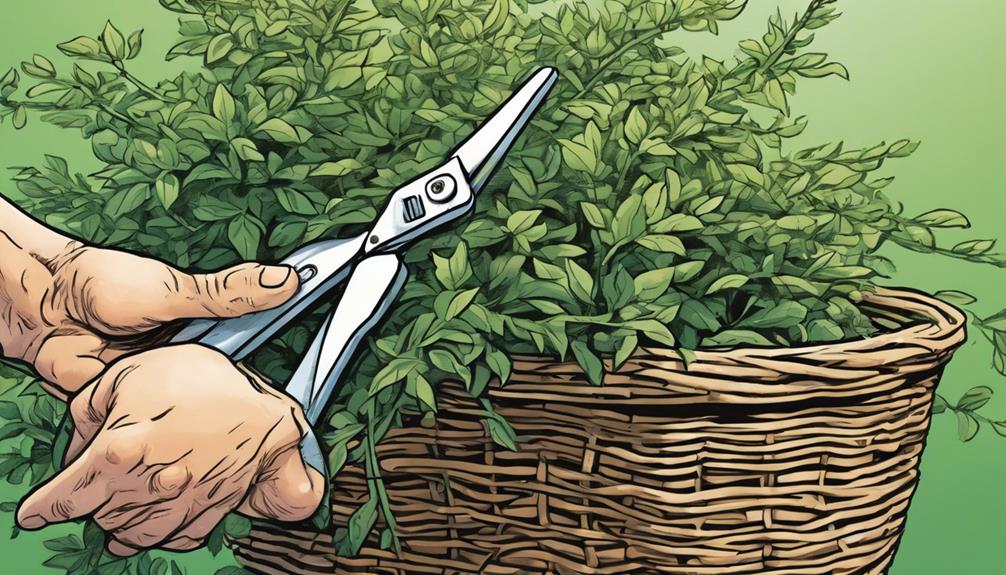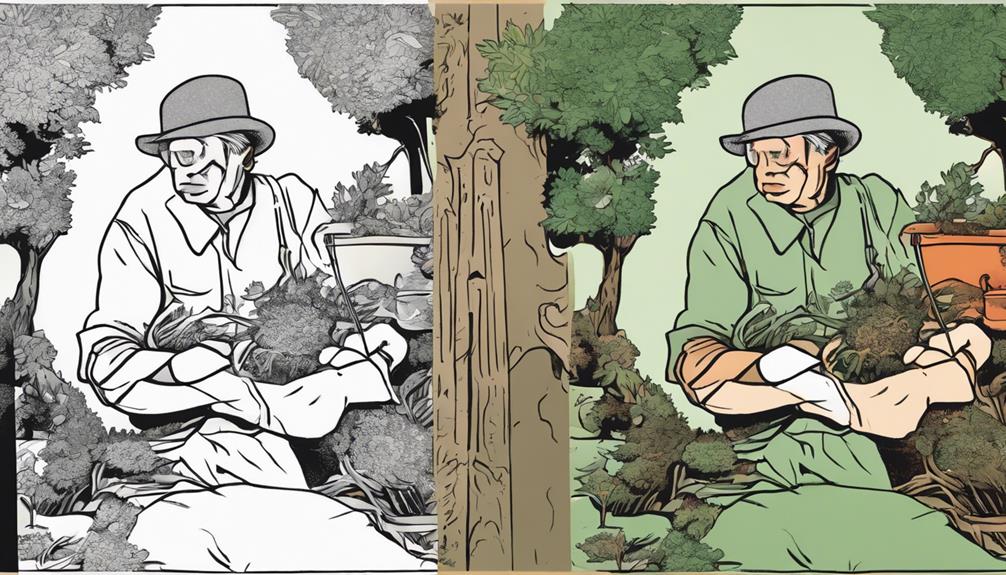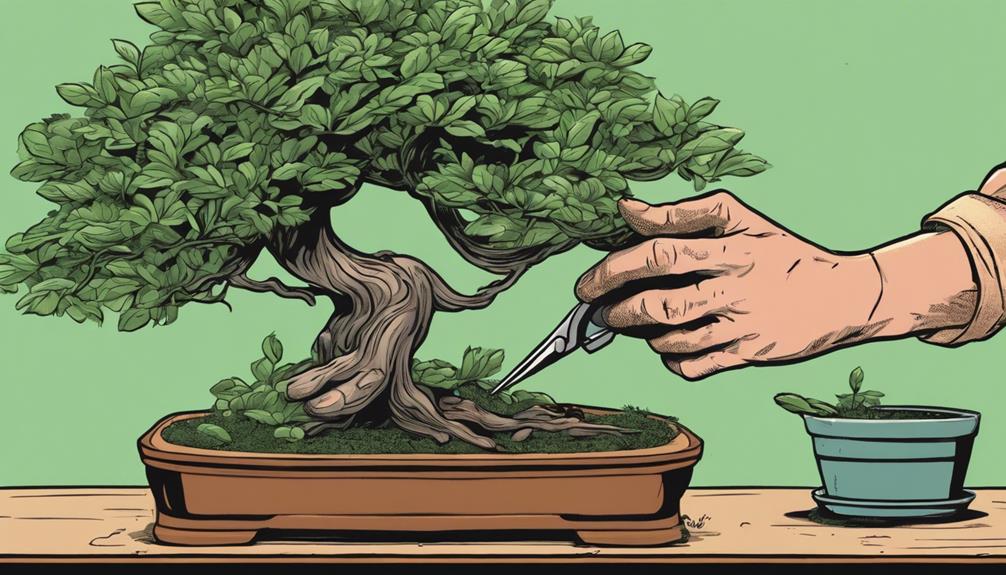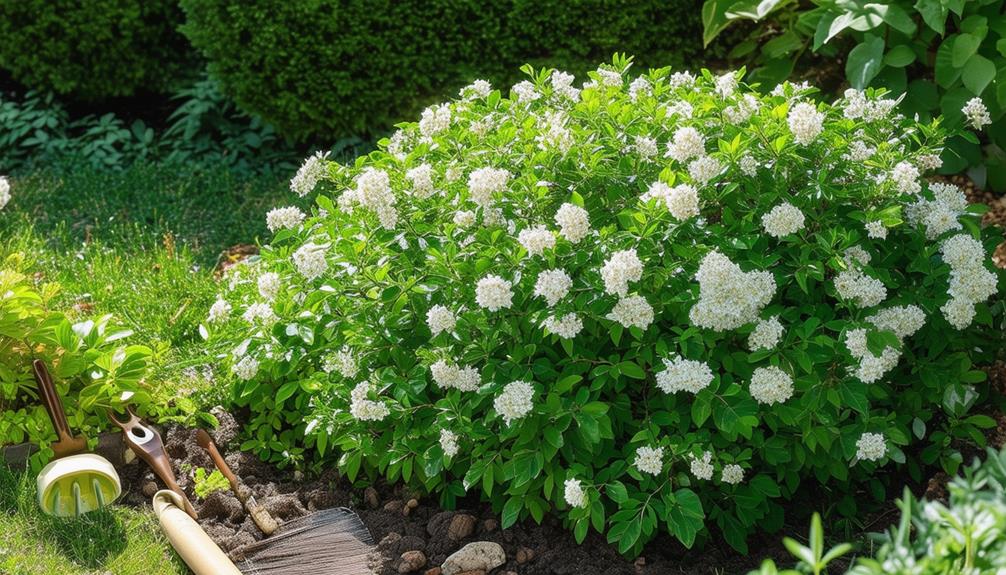By pruning your plants, you can shape, rejuvenate, and enhance their health, promoting healthy growth, increasing air circulation, and encouraging blooming. Proper pruning reduces pest and disease issues, stimulates new growth, and increases fruit production. Different plant types require tailored pruning techniques, such as pruning deciduous trees and shrubs during the dormant season, and using a selective approach for evergreen trees and shrubs. As you master the art of pruning, you’ll discover the secrets to creating stunning ornamental shapes, training plants into hedges and screens, and boosting plant productivity – and there’s more to explore when it comes to refining your pruning skills.
Key Takeaways
• Pruning promotes healthy growth by removing dead, diseased, or damaged branches and encouraging air circulation and blooming.
• Proper pruning reduces pest and disease issues, stimulates new growth, and increases fruit production for improved plant health.
• Pruning techniques like pollarding and coppicing can rejuvenate trees and boost biomass production, enhancing overall plant health.
• Regular pruning helps maintain plant aesthetics by promoting balanced growth, controlling size, and creating ornamental shapes.
• Targeted pruning redirects plant energy for more blooms, fruits, and growth, optimizing plant health and productivity.
Table of Contents
Pruning Plants: Shaping, Rejuvenating, and Enhancing Plant Health

When you start pruning your plants, it’s crucial to understand the principles and benefits of this technique. You’ll want to learn how plants respond to pruning and training, which can greatly impact their growth and health. By grasping these fundamental concepts, you’ll be well-equipped to shape, rejuvenate, and enhance the health of your plants.
Understanding the Principles and Benefits of Pruning
By grasping the principles and benefits of pruning, you can transform your plants from lackluster to lush, as this essential technique empowers you to shape, rejuvenate, and enhance their overall health. Pruning plants is an art that requires understanding the benefits of pruning, which include promoting healthy growth, increasing air circulation, and encouraging blooming. By mastering pruning techniques, you can eliminate diseased or damaged branches, allowing your plants to thrive. Proper pruning also enhances aesthetics, as it allows you to control the shape and size of your plants. Moreover, pruning techniques can stimulate new growth, increase fruit production, and even reduce pest and disease issues. As you explore the benefits of pruning, you’ll discover how this simple yet powerful technique can elevate your plant care skills, giving you the freedom to cultivate vibrant, thriving plants that bring joy and beauty to your space. By incorporating pruning into your plant care routine, you’ll tap into the full potential of your plants, enjoying the many benefits that come with this essential technique.
Plant Growth Responses to Pruning and Training
When you prune your plants, you can expect a range of growth responses, from increased branching to enhanced flowering, depending on the timing, technique, and plant species. As you use your pruning tools to shape and train your plants, you’re influencing their growth patterns. Seasonal pruning, for instance, can promote new growth, encourage fruiting, or stimulate blooming. By pruning during the dormant season, you can redirect the plant’s energy from leaf growth to fruit production or flowering. Thinning out dense foliage can improve air circulation, reducing the risk of disease. Conversely, pruning can also stimulate bushy growth, making your plants more compact and manageable. By understanding how pruning affects your plants, you can tailor your plant care approach to achieve the desired results. Remember, pruning is an art that requires patience, observation, and practice. With the right techniques and tools, you can reveal your plants’ full potential and enjoy a thriving, beautiful garden.
Pruning Techniques for Different Plant Types
As you prepare to prune your plants, you’ll need to take into account the specific type of plant you’re working with, as different techniques are necessary for best results. You’ll learn how to prune deciduous trees and shrubs, evergreen trees and shrubs, and herbaceous perennials and annuals, each requiring unique timing and methods. By mastering these specialized techniques, you’ll be able to promote healthy growth and enhance the beauty of your plants.
Pruning Deciduous Trees and Shrubs: Timing and Methods
What’s the best time to prune deciduous trees and shrubs, and how can you do it effectively? As a gardener, you want to prune at the right time to promote healthy growth and avoid damaging your plants. For deciduous trees and shrubs, the best time to prune is during their dormant season, usually in late winter or early spring. This allows the plant to heal quickly and minimizes the risk of disease.
When pruning, use sharp, clean tools to prevent spreading diseases. Remove any dead, diseased, or damaged branches, cutting them off at the base. For shaping, cut back branches to a bud or a lateral branch, making a clean cut at a 45-degree angle. Don’t leave stubs, as they can provide an entry point for disease. In gardening and horticulture, pruning is an essential technique to maintain plant health and aesthetics. By following these methods, you’ll be able to prune your deciduous trees and shrubs effectively, promoting healthy growth and enhancing their beauty.
Pruning Evergreen Trees and Shrubs: Selective Removal and Shaping
Pruning evergreen trees and shrubs requires a more selective approach than deciduous plants, since they continue to grow year-round and can be more sensitive to improper pruning. You’ll need to identify the branches that are damaged, diseased, or dead, and remove them carefully to prevent spreading disease and encouraging healthy growth. When pruning evergreen shrubs, you can use hand pruners or loppers to remove individual branches or stems. For larger trees, you may need to use a pruning saw or hire a professional.
When shaping evergreen trees and shrubs, you’ll want to consider their natural form and growth habits. For example, you can prune conical-shaped evergreens, like arborvitae, to maintain their natural shape. For more irregularly-shaped shrubs, like juniper, you can prune them to encourage dense growth and maintain their boundaries. Regardless of the type, it’s essential to prune evergreen trees and shrubs during their dormant season, usually in late winter or early spring, to minimize stress and promote healthy growth.
Pruning Herbaceous Perennials and Annuals: Deadheading and Rejuvenation
When it comes to herbaceous perennials and annuals, you’ll need to employ different pruning techniques to promote blooming, encourage new growth, and maintain overall plant health. Deadheading, an essential step in pruning herbaceous perennials, involves removing spent blooms to redirect the plant’s energy towards producing new flowers. Simply snip off the faded flowers at the base, making a clean cut just above a leaf node or bud. This encourages the plant to focus on producing new blooms rather than seed production.
For annuals, you’ll want to focus on rejuvenation pruning, which involves cutting back leggy stems to encourage bushy growth. Using clean, sharp pruning tools, cut back the stems by about one-third to one-half, making cuts just above a leaf node or bud. This will stimulate new growth and promote a fuller plant. Regular pruning will also help maintain plant health by removing diseased or damaged foliage, reducing the risk of disease spread. By incorporating these pruning techniques into your plant care routine, you’ll be rewarded with vibrant, healthy plants that thrive with renewed energy.
Training and Shaping Plants through Pruning

As you prune your plants, you’re not just cutting away dead branches – you’re also shaping their growth and promoting healthy development. By using various pruning techniques, you can train and shape your plants to create stunning visual effects, from intricate topiaries to lush living walls. By mastering these techniques, you’ll be able to create breathtaking displays that showcase your plants’ natural beauty.
| Pruning Technique | Effect |
|---|---|
| Espalier | Trains plants to grow flat against a wall or trellis |
| Topiary | Shapes plants into intricate, ornamental forms |
| Bonsai | Creates miniature, sculpted plants in containers |
Espalier, Topiary, and Bonsai Techniques
You’ll create stunning, sculptural plants by mastering espalier, topiary, and bonsai techniques, which rely heavily on precise pruning to train and shape plant growth. These techniques require patience and dedication, but the results are well worth the effort. To get started, choose a plant with a strong, flexible stem, like a young apple tree or a shrub with a similar growth habit.
For espalier, you’ll need to prune your plant to grow flat against a wall or trellis. Train the stems by gently twining them around the support, securing with soft ties as needed. Topiary involves pruning to create ornamental shapes, like spheres or cones. Use hand pruners to shape the plant, working from the bottom up to maintain symmetry. Bonsai, on the other hand, involves growing miniature trees in containers. Prune roots and stems regularly to control size, and shape the tree to create a balanced, harmonious form. With practice, you’ll develop the skills to craft breathtaking, one-of-a-kind plants that showcase your artistic flair.
Creating Hedges, Screens, and Living Walls
By pruning plants regularly, you can train and shape them into stunning hedges, screens, and living walls that add beauty and functionality to any landscape. These structures can provide privacy, block unwanted views, or create a sense of enclosure. To create a hedge, select plants with similar growth habits and prune them to maintain a uniform shape. For a screen, use plants with a more open growth habit, pruning them to maintain a loose, airy texture. Living walls, also known as green walls, can be created using a trellis or a wall-mounted planter, and require regular pruning to keep the plants healthy and thriving. When pruning, make clean cuts just above a leaf node, using sharp, sterile tools to prevent spreading disease. Prune in the growing season to encourage new growth, and thin out weak or damaged branches to promote healthy development. With regular pruning, you can create beautiful, functional hedges, screens, and living walls that enhance your outdoor space.
Promoting Branching and Controlling Plant Size
To encourage a fuller, more balanced plant, prune your plants to promote branching, which also helps control their overall size and shape. By cutting back the tip of a stem, you’re encouraging the plant to produce more lateral shoots, resulting in a bushier appearance. This technique is especially useful for plants that tend to grow leggy or have an uneven shape.
When pruning for branching, focus on the terminal buds, which are the buds at the end of each stem. Cut just above a node, which is the joint where a leaf meets the stem, using a 45-degree angle cut. This will help the plant heal quickly and reduce the risk of disease. Make clean cuts, and avoid tearing or ripping the stem, as this can cause damage to the plant.
Pruning for Plant Health and Productivity
As you prune your plants, you’ll want to focus on removing dead, diseased, or damaged branches to prevent the spread of disease and encourage healthy growth. By thinning out crowded growth, you’ll improve air circulation and create a more conducive environment for your plants to thrive. By doing so, you’ll stimulate flowering, fruiting, and vigorous growth, ultimately leading to a more productive and resilient plant.
Removing Dead, Diseased, or Damaged Branches
You’ll want to prioritize removing dead, diseased, or damaged branches, as these can spread decay and attract pests, ultimately compromising your plant’s health and productivity. These branches can be identified by their wilted, discolored, or brittle appearance. To remove them, use clean, sharp pruning tools to cut at the branch collar (the raised area where the branch meets the trunk). Make a clean cut, angling it slightly to prevent water from collecting. Remove any weak or crossing branches that can rub against each other, causing damage. Don’t forget to disinfect your tools between cuts to prevent the spread of disease. By removing these problematic branches, you’ll prevent the spread of decay and encourage healthy growth. Your plant will thank you!
Thinning Crowded Growth to Improve Air Circulation
By selectively removing branches, you can thin out crowded growth, improving air circulation and allowing sunlight to penetrate deeper into the plant’s canopy. This is especially important in dense shrubs or trees, where overcrowding can lead to fungal diseases and pest infestations. To thin crowded growth, identify the branches that are crossing or rubbing against each other, as these can create entry points for disease. Cut these branches off at their base, making a clean cut just above a growth node. This will encourage the plant to focus its energy on healthy growth. Additionally, remove any weak or spindly branches, as these can drain the plant’s resources without providing much benefit. By thinning crowded growth, you’ll improve air circulation, increase sunlight penetration, and promote healthy growth. Remember to prune during the dormant season or during a period of slower growth to minimize stress on the plant.
Stimulating Flowering, Fruiting, and Vigorous Growth
Now that you’ve improved air circulation by thinning crowded growth, it’s time to focus on stimulating flowering, fruiting, and vigorous growth by pruning select branches. This targeted pruning will encourage your plants to produce more blooms, fruits, and lush foliage. To stimulate flowering, identify and prune branches that are growing inward or crossing over others, as these can reduce blooming. Cut these branches back to the point where they meet a healthy, outward-facing branch. For fruiting plants, prune branches that are weak or spindly, as these can divert energy from fruit production. Remove any dead, diseased, or damaged branches, as these can spread disease and pests. By pruning these select branches, you’ll redirect your plant’s energy towards producing more flowers, fruits, and healthy growth. Remember to prune during the plant’s dormant season to minimize stress and promote healthy regrowth. With these targeted pruning techniques, you’ll be enjoying a bountiful harvest and vibrant blooms in no time!
Specialized Pruning Techniques

As you explore specialized pruning techniques, you’ll discover ways to enhance plant health and productivity. These advanced methods require precision and attention to detail, but the benefits are well worth the effort. By mastering these techniques, you’ll reveal new possibilities for your plants:
- Pollarding and Coppicing: Rejuvenate and boost biomass production in trees and shrubs.
- Grafting and Budding: Propagate new plants and improve variety through precise union of scion and rootstock.
- Canopy Management: Optimize fruit tree and grapevine yields through strategic pruning and training.
- Espalier and Trellising: Train plants to grow along walls, fences, or trellises, maximizing space and aesthetics.
Pollarding and Coppicing for Rejuvenation and Biomass Production
You can revitalize old or damaged trees and stimulate biomass production by adopting two specialized pruning techniques: pollarding and coppicing. These methods allow you to rejuvenate trees, promote healthy growth, and even harvest biomass for energy or other uses. Pollarding involves cutting a tree back to its main branches, encouraging new growth and a more compact shape. Coppicing takes it a step further, cutting the tree to ground level to stimulate rapid regrowth and biomass production. Both techniques require careful planning and timing, as they can be stressful for the tree. You’ll want to prune during the dormant season, making clean cuts just above a growth node to minimize damage. By adopting pollarding and coppicing, you can breathe new life into struggling trees, create a sustainable biomass source, and enhance the aesthetic appeal of your landscape. With practice and patience, you’ll master these specialized pruning techniques and harness their many benefits.
Grafting and Budding for Propagation and Variety Improvement
By combining grafting and budding techniques with pollarding and coppicing, you can further enhance your plant propagation capabilities and introduce new varieties to your landscape. These specialized pruning techniques allow you to merge the root system of one plant (the rootstock) with the stem of another (the scion). This union enables the scion to grow and thrive on the robust root system, producing a new, improved plant. To graft, you’ll need to prepare the scion by cutting it from the parent plant, then join it to the rootstock using a grafting tape or wax. Make sure the cambium layers align, as this promotes healthy callus formation. Budding, on the other hand, involves attaching a single bud from one plant to the rootstock of another. This technique is particularly useful for fruit trees and grapevines, allowing you to introduce new varieties and improve yields. By mastering grafting and budding, you’ll discover new possibilities for plant propagation and variety improvement, giving you the freedom to create a diverse and thriving landscape.
Canopy Management in Fruit Trees and Grapevines
Effective canopy management in fruit trees and grapevines involves strategic pruning to balance fruit production, air circulation, and sunlight penetration. As you prune, you’ll want to remove crossing branches, diseased or damaged wood, and any water sprouts. This will improve air circulation and reduce the risk of disease. In fruit trees, you’ll also want to thin out fruiting branches to allow more sunlight to reach the fruit. For grapevines, you’ll need to prune for both fruit production and canopy management. You’ll want to remove any weak or damaged shoots, as well as any shoots that are growing inwards or downwards. This will help direct the vine’s energy towards producing healthy, fruitful growth. When pruning, make clean cuts just above a bud or a lateral branch, and always disinfect your pruning tools between cuts to prevent the spread of disease. By following these steps, you’ll be able to maintain a healthy, productive canopy that will thrive for years to come.
Frequently Asked Questions
Can I Prune Plants at Any Time of the Year Safely?
You can prune plants at various times of the year, but it’s important to take into account the plant’s growth cycle. Prune during the dormant season (winter) for deciduous plants, and during the active growing season for evergreen plants. Avoid pruning during extreme weather conditions, like intense heat or cold, as this can cause stress to the plant. Prune at the right time to guarantee a healthy, thriving plant.
Do I Need to Disinfect My Pruning Tools Between Cuts?
As you wield your pruning shears, imagine a sword of precision, slicing through disease and decay. But, do you need to disinfect your trusty tool between cuts? Yes, you should! Fungi and bacteria can easily spread from plant to plant, causing harm. Sanitize your tools with a 10% bleach solution or alcohol wipes between cuts to prevent the spread of disease, ensuring a healthy and thriving garden.
How Do I Prevent Pruning From Causing Stress to Plants?
To prevent pruning from causing stress to plants, you’ll want to prune at the right time. Prune during the plant’s dormant season or when it’s not under heat stress. Make clean cuts, just above a growth node, and don’t remove too much foliage at once. This will minimize shock and allow the plant to recover quickly. You’re aiming to promote healthy growth, not cause unnecessary stress.
Can Pruning Be Used to Control Pests and Diseases?
You’re wondering if pruning can be used to control pests and diseases? Absolutely! Pruning can effectively remove infested or infected areas, preventing the spread of disease and pests. By cutting out affected parts, you’re stopping the problem from spreading and giving your plant a chance to recover. This technique is especially useful for dealing with fungal diseases, bacterial infections, and pests like aphids or whiteflies.
Are There Any Plants That Should Never Be Pruned?
“Cut to the chase” and get straight to the point – when it comes to pruning, some plants are off-limits. You’ll want to exercise caution with delicate or sensitive species, like succulents or cacti, which can be easily damaged. Likewise, newly planted trees or shrubs should be left untouched to establish a strong root system. Always research the specific pruning needs of your plant to avoid causing more harm than good.
Conclusion
As you put down your pruning shears, step back, and admire your handiwork, remember that the art of pruning is a journey, not a destination. With every snip, you’re not just shaping plants, you’re crafting a masterpiece of health, beauty, and vitality. The transformative power of pruning lies in your hands, waiting to be harnessed. Will you accept the challenge and reveal the full potential of your garden? The pruning journey starts now, and the results will be a cut above the rest.
Back to our main Plant Care Guide.

